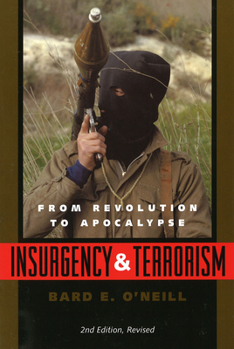Insurgency and Terrorism: From Revolution to Apocalypse, Second Edition, Revised
Select Format
Select Condition 
Book Overview
A systematic, comprehensive, and straightforward textbook for analyzing and comparing insurgencies and terrorist movements, Insurgency and Terrorism was first published in 1990 to broad acclaim.... This description may be from another edition of this product.
Format:Paperback
Language:English
ISBN:1574881728
ISBN13:9781574881721
Release Date:June 2005
Publisher:Potomac Books
Length:240 Pages
Weight:0.85 lbs.
Dimensions:0.6" x 5.9" x 8.9"
Customer Reviews
4 ratings
A Guide for the Topic
Published by Thriftbooks.com User , 17 years ago
This book give types of Insurgencies that history has show us and the definitions that make them different to each other.
Great Reference
Published by Thriftbooks.com User , 18 years ago
This is an excellent book. The author is a well known and respected expert of the field. The book begins with an introduction that attempts to level set and baseline definitions and meanings. Although this may appear to be semantics, the differences both subtle and great is important. The book is well organized it is easy to refer to a specific chapter or section in the event you need a quick refresher and or reference. The book is well written, concise and offers a large quantity of foot notes at the end of each chapter. This book is for both the expert and the novice. Terry Tucker, Adjunct Professor, Military Studies/History University of Maryland and Senior Doctrine Developer SANGMP, Vinnell Arabia
Beginning to Develop a Science of Terrorism
Published by Thriftbooks.com User , 19 years ago
I had never thought of insurgency and terrorism as having enough material to justify having a textbook on the subject. Then again I didn't realize just how many different insurgencies are going on at any one time. In fact, he concentrates on the contemporary world, only mentioning in passing that Roman Armies also fought insurgents. Part of a scientific analysis is to classify them into types based on common attributes. By assigning names to these classes, we make it so that we can use these names and immediately know what kinds of programs have worked against them in the past, and of course what have not. Dr. O'Neill has looked into the Types of Insurgencies, Politics and forms of Warfare, Insurgent Strategies, the Physical Environment, the Human Environment, Types of Popular Support, Organizational Structure, External Support, and Government Response. Through these classifications, he is, for the first time beginning to draw together a consistent approach to the study of terroism. Perhaps this is the start of a Terrorism Science to go along with Naval Science or Military Science.
Excellent framework for analysis
Published by Thriftbooks.com User , 19 years ago
This is an excellent framework for analysis, but you will need specialist information which is both current and validated before you can do much more than generalize in any given situation. Still, even this can be quite useful. I came across this book while reading "Peace Operations in an Insurgency Environment", a paper written by Major Grootendorst for the CSC in 1997. In this paper he effectively uses the marketing management model of Kotler to combine the Mackinlay and Chapra theory of peace operations with O'Neill's insurgency model. Very nicely done. (I like Kotler - he seems to view business as war by other means!) O'Neill's treatment is necessarily very narrow. Except in passing, his scope does not include pre-insurgency nor post-insurgency. I don't find this a deficiency with his work, but I do find it a deficiency with our thinking about insurgency. A common agreement among participants at the recent Disarmament, Demobilization, and Reintegration course sponsored by the Norwegian Defense Force in Oslo is that we need to move beyond the central focus on insurgency. Necessary as it is to "calm the waters", current process does not seem to solve the underlying structural problems which then rise to a boil every decade or so -- and in addition the initial societal disturbance creates generational shockwaves that take decades of sincere and costly efforts to reduce to a manageable level. While O'Neill's is the close examination of a particular facet of a problem, we cannot afford to be so parochial. I strongly recommend this book. Much of what we have seen come to pass in Iraq was largely predictable, at least in broad brush strokes, based on competent consideration of his model. (I actually read the book in early 2002 and have reviewed it again just this month.) Just keep in mind the broader picture -- think outside the box. We seem to be doing the same things over and over again, only harder and faster; and then seem surprised when we get the same results -- only quicker. A clear prerequisite is being able to empathize (as opposed to sympathize) with the opponent, no matter how we feel about his actions.





